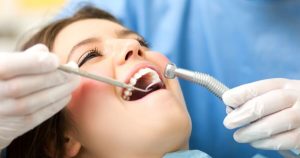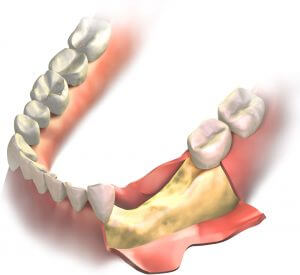Has your dentist said you need a dental bone graft for implants? It might sound daunting, but this surgical procedure is sometimes necessary when the jaw bone is too weak to support implants. If it means you can get the teeth implants you need to restore your smile, it’ll surely be worth it in the long run!
No doubt you have a lot of questions about what a bone graft costs in the UK, the materials they use, what the procedure is like, and how long it’ll take to recover. So in this guide we’re going to answer all these questions and more to help you feel more at ease with the decision.
Get a free quote for dental treatment abroadWhat is a bone graft?

A bone graft, or bone augmentation, is most often used in restorative dentistry to bulk up and strengthen the jawbone before having teeth implant surgery. Periodontal disease, infection, and trauma can all affect the bone structure, making this procedure necessary. And if you have been missing teeth for some time, your jawbone will start to recede and lose density, making it unfit for implantation.
Children born with a cleft palate may need an alveolar bone graft to restore their jaw.
During jaw bone grafting, natural or synthetic bone material is used to fortify the existing jaw bone and make implant surgery possible.
Watch the short video below where Dr Charles Lister gives a great explanation, likening it to planting a carrot!
There is a lot more to it than this, of course, so let’s look at some different types of dental bone graft.
Dental bone graft procedure
One of several different techniques may be used for your graft, depending on the condition of the remaining bone and the type of dental work you need. These techniques are broadly classed as follows:
Socket graft
It’s possible to get a tooth extraction and bone graft on the same day with a socket graft. This involves placing the bone material directly into the socket immediately after extraction. This is a preservation technique, aiming to avoid the bone loss which usually occurs in the year or two following extraction. Around six months later, the jaw should be ready to support an implant.
A socket graft may also be referred to as ‘minor’ bone graft surgery, as opposed to the ‘major’ techniques described below.
Block bone graft
Block bone grafts are typically performed when significant bone loss has occurred after tooth extraction or because of gum disease or trauma. A small piece of bone tissue is cut to exactly the right shape and secured with screws. After several months of healing from the bone augmentation procedure, the body will be ready for dental implant surgery.
Alternatively, if the space to be filled is irregular in shape, a softer material can be used to repair it. This is covered with a membrane, and over several months it fuses with the natural bone.
The following video gives an illustrated explanation to help you visualise these techniques:
Sinus Lift and bone graft
A sinus lift is a kind of dental surgery that may accompany a bone graft for dental implants. If there is insufficient bone availability on the upper jaw, placement of implants may interfere with the sinus cavity above. In this case, an oral surgeon will access the sinus cavity and lift it up before placing the new bone material below. Then, there is no risk of damage to the sinuses when the implant is placed, around four to six months later when the area has healed.
How long does bone graft surgery take?
As you have seen, the different types of bone graft require different degrees of surgical treatment. A socket graft may add just 15-20 minutes to the tooth extraction appointment, while a block graft is likely to take 45-90 minutes.
The duration will also depend on the material being used; if it has to be extracted from elsewhere on your body then this will lengthen the bone graft treatment time.
Get a free quote for dental treatment abroadDental bone graft material

There are many different materials used for bone grafting but they can generally be divided into three categories:
- Autograft: Uses bone taken from another area of your body (often the iliac crest of the hip)
- Allograft: Uses bone taken from a human donor or cadaver for use in medical procedures
- Xenograft: Uses bone taken from another animal source (often bovine)
- Alloplast: Uses synthetic biocompatible material, usually containing hydroxyapatite or calcium phosphate, both naturally occurring minerals
Each has its own benefits and risks of complication, which your surgeon can explain to you.
A consultation with your oral and maxillofacial surgeon is the first step to determining where the bone grafting material will come from. Most dental grafting procedures involve a combination of autogenous bone or autograft (bone that is harvested from another area of the patient’s body), allografts (bone from a bone bank) or xenografts (bone from another animal).
If your doctor decides that an autograft is appropriate, it is likely that the bone graft will come from another part of the jawbone. If a large quantity of bone is needed then bone may also be obtained from the hip or lower leg. There are two main reasons for this: the quantity of bone available in those areas and the convenient access for the procedure.
Autograft is often seen as the ideal way to go for jaw bone graft patients because it stimulates bone growth with live bone cells. Other graft materials are used with autografts to increase the volume of the graft and make it more stable over time. Of course, with an autograft, you will have a second wound that needs to heal following surgery.
How much does a dental bone graft cost in the UK?
Bone graft costs are heavily influenced by the type of material used, as well as the technique. In the UK, the cost of a dental bone graft ranges from £200 – £2,500 and perhaps more.
Generally speaking, synthetic materials are the cheapest, followed by bovine and human donor bone. Bone graft surgery costs more if you’re using your own bone since it needs to be extracted from the donor site. But, as this method can increase the chance of success, it may be a price worth paying.
The table below gives approximate bone graft costs in the UK, according to the type of surgery:
Approximate cost | |
Socket (minor) graft | £200 - £1,200 |
Block bone (major) graft | £1,200 - £2,500 |
Additional sinus lift (per sinus) | £500 - £2,000 |
Can you get a dental bone graft on the NHS?
With costs like that, you might be wondering if you can get a dental bone graft on the NHS. Unfortunately, the short answer is probably not, because of limited funding. As dental implants are rarely covered on the NHS, any preparatory surgery like a sinus lift or bone graft for implants also won’t be covered.
There are some exceptions worth noting. For example, if your tooth loss occurred from severe trauma or another medical condition then you may be covered for implants with a bone graft on the NHS.
Some patient’s jaw bones are so badly deteriorated that they are unable to support dentures or a bridge. Since both these restorative options are available on the NHS, bone grafting for dentures or a bridge may also be covered. Your dentist will be able to advise you about your specific situation, but most people will have to pay private bone graft prices.
One way to reduce the cost is to consider getting dental implants abroad. In countries like Spain, Turkey and Hungary you can save 50-70% on the cost of implants and associated surgeries.
We look forward to being able to help you save up to 70% on the dental care you need!
Possible complications
Before your grafting procedure, it is important to discuss possible dental bone grafting complications with your dentist or surgeon. Although they use well-developed techniques, there are possible risks, including:
- Rejection: The donor grafts are not accepted by the patient’s body and are rejected; the body pushes out what it sees as a foreign object instead of fusing with it and growing new bone.
- Infection: If the procedure is done in a contaminated environment or there isn’t proper aftercare to ensure the site is clean, then risk of infection increases. This risk is minimised with antibiotics.
- Nerve damage: This may occur at the donor site or the grafting site. Nerve pain can be temporary or chronic.
If you are worried about these or other bone graft side effects, speak to your surgeon about how you can minimise the risk of complication through your choice of material and aftercare. The risk of bone graft failure is higher in individuals who smoke, and your doctor will advise you if you are a particularly high-risk patient.
Those who want to avoid this procedure altogether may be able to get mini dental implants, although these come with their own set of risks.
Dental bone graft recovery & healing
Dental bone graft recovery is typically an outpatient procedure, meaning you don’t need to stay in hospital afterwards but can instead heal at home. If you are recovering after a bone graft from your hip, you will have two areas healing at the same time. This article has some helpful information about hip bone graft healing.
It’s important you pay attention to your surgeon’s instructions to help you recover faster and avoid an infection after your dental bone graft.
What to expect
After your grafting surgery has taken place, the initial recovery period will be about two weeks. During this time you may experience several things:
Day of surgery

- Bleeding: Some bleeding is normal, and you should change your bandages as directed.
- Swelling: There is likely to be some swelling as well. Depending on the severity of the operation the swelling can affect more than just your mouth, including your cheeks, eyes, and the side of the face. Ice packs are a good way to bring down the swelling and ease the pain associated with it.
- Pain: This procedure can result in some pain and discomfort. Your doctor might prescribe you some strong painkillers; otherwise you can take paracetamol or ibuprofen to manage this.
Plan to rest for at least one or two days after your surgery, and avoid strenuous exercise for a few days more. Some other things that your healthcare provider will go over with you before sending you home include:
Two weeks after surgery
- Antibiotics: It’s common to be prescribed antibiotics after bone graft surgery. These help fight off any infection as your body heals and adjusts. You should finish the course of antibiotics prescribed to you, even if you feel fine.
- Diet: Prepare to eat only soft foods for a while after the surgery, to avoid damaging the soft tissue around the graft. At the same time, you should try to eat a healthy diet to strengthen your body’s immune system. Dairy is not recommended as it contains live bacteria that can harm the surgery site.
- Smoking: Since smoking is a risk factor for bone graft failure, it’s recommended you avoid smoking during your recovery.
- Oral Hygiene: After the operation, you will need to take some special steps to keep your mouth clean. Your doctor will give you instructions. They may include rinsing your mouth out with a mouthwash prescribed by your doctor twice or more a day. Keeping your mouth clean while it is healing is incredibly important.
It will take several more months for the graft to fully integrate with your jawbone, a process known as osseointegration. Once this is complete, you can go ahead and have your teeth implants placed.
If at any time during your dental bone graft healing you experience pain that worsens or doesn’t go away, you should contact your healthcare provider to notify them. This is a sign of dental bone graft failure, so don’t ignore it.
To learn more about the dental bone graft healing stages you might want to read this article, but be warned, it contains some graphic images of the surgery.
Conclusion

A bone graft is used in restorative dentistry to restore and strengthen the jawbone before having implant surgery, and occasionally in other restorative procedures. The process involves taking material from either the patient’s body, a cadaver, an animal, or synthetic sources and placing it in the jawbone to fuse with the original bone. There are several types: block bone graft, socket graft, and sinus lift.
The cost of a bone graft varies from £200 to £2,500 or more, according to the procedure and materials used. If you need a sinus lift, this will incur an additional cost. Your surgeon will discuss the different options with you to help you decide on the best course of action.
The bone graft healing process will involve some swelling and pain at first, as well as a little bleeding. Follow instructions to minimise this discomfort, and you should feel back to normal within a couple of weeks. You should also take steps to reduce the risk of rejection or infection.
It will take several months more for the new bone to fuse with your jaw, but then you’ll be ready to finally get those implants you’ve been dreaming of!
We look forward to being able to help you save up to 70% on the dental care you need!
FAQs
Can I wear a denture following bone grafting whilst waiting for implants?
This will depend on the condition of your jaw bone following the graft. There may still be insufficient bone to comfortably support a denture, and your jaw will be quite swollen for a while.
Can I have a bone graft and implant done at the same time?
Yes, in certain circumstances you can get a dental implant with a bone graft at the same time. This will depend on the shape and condition of your jaw bone, as well as some other factors.
Can your body reject a bone graft?
Yes. To minimize the risk of rejection, the patient can opt to use material from their own body or a human donor/cadaver. Following the correct aftercare instructions will also help.
Is a bone graft painful?
The area will be fully anaesthetised during the procedure so you shouldn’t feel any pain. The are is likely to be sore for a few days but you can take painkillers to help with this.
What’s a normal dental bone graft recovery time?
You should feel better within a few days and fully recovered within a week or two. However, it will be several months more before your jaw is ready to support implants.
What is a bone graft made of?
The bone used for grafting can come from the patient’s own body, a donor or cadaver, animal bone, or synthetic materials. There are various pros and cons to each of these.
What does a dental implant and bone graft cost in the UK?
Since both costs are so variable, it’s hard to give a good estimate. Most clinics charge £2,000 or more for a tooth implant and £500 or more for a simple bone graft, so the total cost will be £2,500 – £3,000.
NCBI: Bone Grafts in Dentistry. Consulted 19th, April 2020.
NCBI: Socket grafting: a predictable technique for site preservation. Consulted 19th April 2020.
NCBI: The rate and stability of mandibular block bone graft in recent years. Consulted 19th April 2020.
Oral Health Group: Bone Grafts For Implant Dentistry: The Basics. Consulted 19th November 2020.





